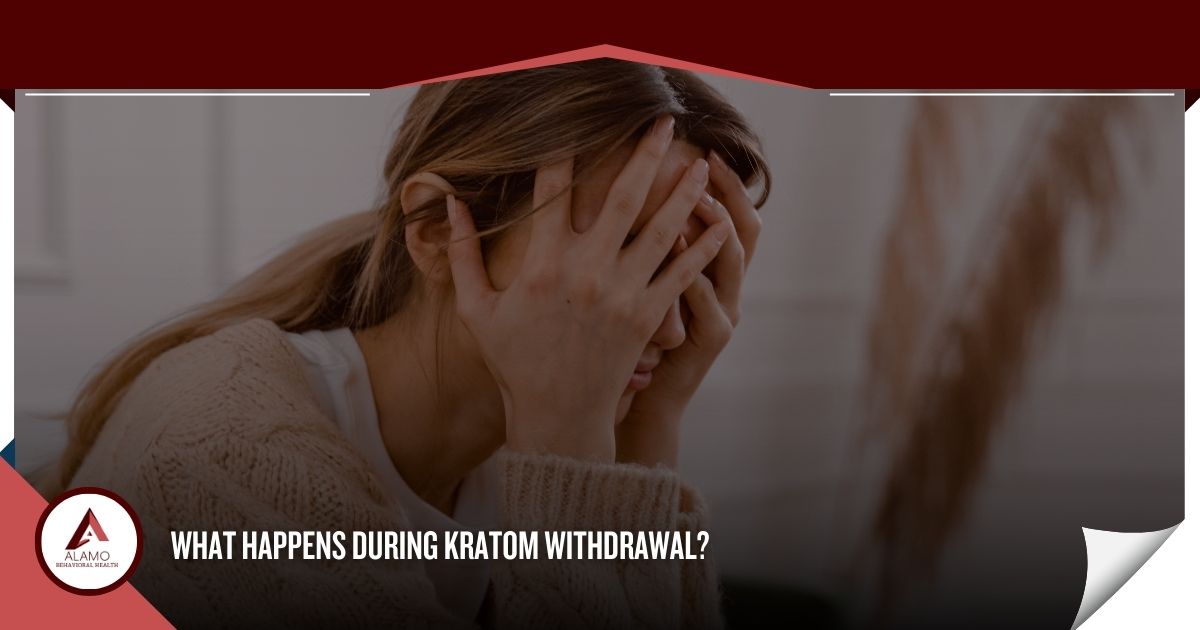Kratom is a powerful, addictive substance that is available from retailers throughout the United States. Manufacturers label and advertise kratom as a natural dietary supplement, but it has the potential to be dangerous.
People who abuse kratom may have symptoms of addiction, including withdrawal. This article will explore kratom withdrawal.
What you will learn:
- The effects and risks of kratom abuse
- The effects of kratom withdrawal
- How long kratom withdrawal may last
- What to expect during kratom withdrawal treatment
- How to find substance abuse treatment and support
Contact the Alamo Behavioral Health specialists to learn more about kratom addiction or to find treatment. Our intake staff can verify your insurance, answer questions, and schedule an intake assessment so that you can begin your recovery journey as soon as possible.
What is Kratom?
Kratom is a substance that comes from a Southeast Asian plant called Mitragyna speciosa. Smoke shops and other retailers may sell Kratom in tablet, liquid, or powder form.[1,2]
The Drug Enforcement Administration (DEA) does not regulate kratom. However, the DEA has recently marked kratom as a “drug of concern” and has issued public warnings about this dangerous legal substance.
Similarly, the Food and Drug Administration (FDA) issued a warning to the public about the risk of ingesting kratom. It warned that the production of kratom is unregulated, and the product may be toxic.[2]
Research links kratom abuse to cases of psychosis or dangerous sedation.[3] In some instances, federal agencies have seized and destroyed kratom products because they pose a risk to the public.
While people may believe that all legal products are safe to use, kratom is a dangerous substance with the potential to cause long-term harm. It is essential to avoid using kratom. People who abuse kratom must seek treatment to detox from it and prevent relapse safely.
The Effects and Risks of Kratom
Kratom works by affecting the brain’s opioid receptors. Many of kratom’s effects mirror the effects of opioids. People with opioid addiction may attempt to replace opioids with kratom, believing it is a safer alternative to these addictive drugs.
The short-term effects of kratom include:[4]
- Euphoria and pleasure
- Decreased pain
- Increased alertness
- Sedation
There is not enough research to demonstrate that kratom is physically addictive. However, people who frequently abuse kratom may exhibit symptoms of addiction, including:
- Needing to take more frequent or higher doses to get the desired effects
- Having cravings for kratom
- Experiencing withdrawal symptoms if they stop using it
People may experience uncomfortable withdrawal symptoms that make it very challenging to quit using kratom long enough to have a complete detox.[5] People who experience symptoms of kratom addiction may require the support of a medically-supported detox program.
The Symptoms of Kratom Withdrawal
People who abuse kratom may experience withdrawal symptoms if they stop taking it. Some of these symptoms may be similar to opioid or other controlled substance withdrawal.
Common kratom withdrawal symptoms include:
- Anxiety
- Depression
- Hot flashes
- Insomnia
- Muscle tension
- Nausea and vomiting
- Mood swings
- Restlessness
- Runny nose
- Sweating
- Tremors
- Watery eyes
People going through kratom withdrawal may face some of the same challenges as people in opioid withdrawal. The withdrawal process can be very challenging. People who attempt to quit “cold turkey” are more likely to relapse.
Medical supervision and addiction treatment can help people with kratom dependency have a safe, complete detox.
How Long Does Kratom Withdrawal Last?
Kratom withdrawal can be very uncomfortable. Understanding what to expect during each stage of the withdrawal timeline can help you stay focused and committed to the process of recovery.
Here is an overview of the symptoms and treatment you expect during each stage of the kratom withdrawal timeline.
12-48 hours
You may begin to experience early withdrawal symptoms within 12-48 hours after your last dose of kratom. Symptoms may include:
- Nausea
- Agitation and restlessness
- Tremors
- Sweating
During this stage, medical professionals will assess your withdrawal symptoms and provide treatment as needed. Treatment may include:
- Over-the-counter or prescription medications to reduce discomfort
- Emotional support
- Mental health treatment
- Supervision and a safe environment
This treatment can keep you safe and comfortable during the earliest days of recovery.
24-72 hours
Your symptoms may intensify over the first three days of detox. You may experience new symptoms, including:
- Insomnia
- Hot flashes
- Diarrhea
- Depression
These symptoms can make you feel miserable. Your treatment team will continue to assess your symptoms and provide treatment as needed.
Three days-one week
Many people begin to feel much better after the third day of detox. Symptoms may become more manageable. However, symptoms can linger for a week or more after your last dose.
Many factors can affect the severity and duration of your withdrawal symptoms, including your health, co-occurring mental health conditions, and your substance use. People who use kratom in high doses or for longer periods of time often experience more intense withdrawal symptoms.[6] Treatment and support are essential to your success in recovery.
Seek professional treatment and continuing community support to help you stay on track as you work toward a healthier future.
Find Treatment Now
If you or someone you love struggles with substance abuse or addiction, you are not alone. Contact the team at Alamo Behavioral Health to learn about our comprehensive treatment programs or to find support at any stage of your recovery.
References:
- National Institute on Drug Abuse (NIDA): Kratom
- United States Drug Enforcement Administration (DEA): DEA Announces Intent To Schedule Kratom
- National Institute of Health (NIH): A Case Report of Kratom-Induced Psychosis
- DEA: Drug Fact Sheet Kratom
- Johns Hopkins University: Assessment of Kratom Use Disorder and Withdrawal among an Online Convenience Sample of US Adults
- NIH: Kratom withdrawal: Discussions and conclusions of a scientific expert forum







